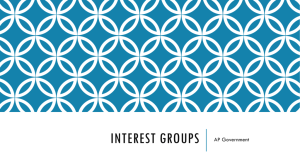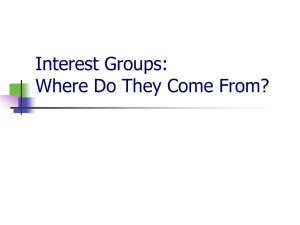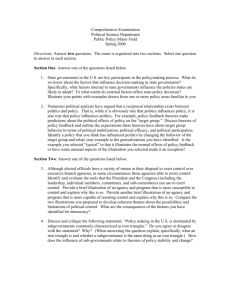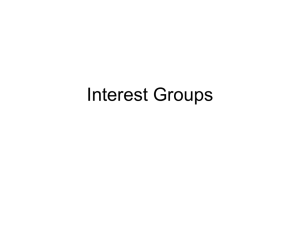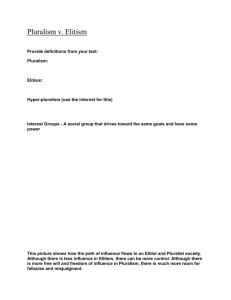Interest Groups
advertisement
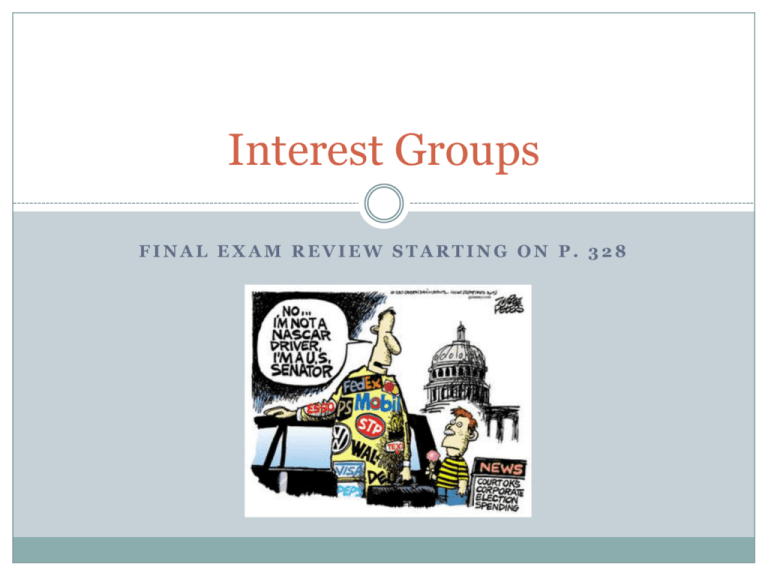
Interest Groups FINAL EXAM REVIEW STARTING ON P. 328 Review Pamphlet 3 FOLD BROCHURE STYLE Layout First page label: PLURALISM Second page label: Elitism Third page label: Hyperpluralism First page label: Iron Triangles Second page label: Vocab Third page label: Interest Groups Interest Group Definition An organization of people who have similar policy goals who enter the political process to try to achieve those goals Interest Group Theories OPINIONS ON HOW BENEFICIAL OR DETRIMENTAL INTEREST GROUPS ARE TO AMERICAN GOVERNMENT Interest Group Theories: Pluralism Pluralism Interest groups bring representation to all Groups win some and lose some but no one loses all the time Competition is good Group theory: IG provided a link between people and government IG compete No one group can become dominant IG’s usually play fair IG’s weak in one resource can use another Weak in money, strong in numbers Interest Group Theories: Elitism Elitism Assertions: Real power is held by Numerous groups relatively few groups Wal-Mart, Oil companies, etc Majority of the public agrees with this theory Argument: 1/3 of top business positions hold more than one position Corporate Boards, university trustees Interlocking directorates mean nothing because groups are unequal Largest corporations hold most of the power Interlocking directorates Corporate elites always prevail Interest Group Theories: Hyperpluralism Hyperpluralism The problem is interest group liberalism Government is overly deferential to groups, with all demands seen as legitimate and government should listen to everyone As a result, government grows out of control Assertions: Groups have become too powerful as government as tries to please everybody Trying to please everybody results in policy gridlock Iron Triangles Iron Triangles Subgovernments are composed of 3 things working together: Interest groups, Government agencies, and members of Congressional committees These iron triangles are the main policy makers Iron Triangles Vocabulary: 16 words What makes certain interest groups successful? P. 336 AP GOV FINAL EXAM REVIEW In summary, interest groups are successful if They are more focused (intensity) Single-issue groups They’re smaller They limit membership and more importantly membership benefits Free-rider problem Selective benefits One thing to remember: Money is important, but it doesn’t guarantee success Tactics of interest groups P. 339 AP GOV FINAL EXAM REVIEW In summary, interest groups use 4 tactics 1. Lobbying Communication by someone acting not on his/her own behalf directed to a government decision maker with the hope of influencing their decision 1. Regular paid employees 2. Temporary 2. Electioneering Aiding candidates financially Money is donated through PACs 3. Litigation Going to court Amicus Curiae briefs Class action lawsuits 4. Appealing to the public Advertising campaigns Public Relations (PR) 4 ways lobbyists actually help Congress: 1. They provide information 2. They can help politicians with strategy for getting laws passed 3. They can help members with their campaigns and getting reelected 4. They are a source of ideas Types of interest groups P. 347 AP GOV FINAL EXAM REVIEW Types of Interest Groups Economic Environmental Corporations Sierra Club Labor unions Nuclear power Arctic National Wildlife Refuge Types of Interest Groups Equality Public Interest NAACP Seek a collective good, NOW the achievement would not just benefit the members but everyone Consumer groups Ralph Nader and public safety FINAL EXAM T H U R S D A Y , J A N U A R Y 1 4 TH 9:00 AM
